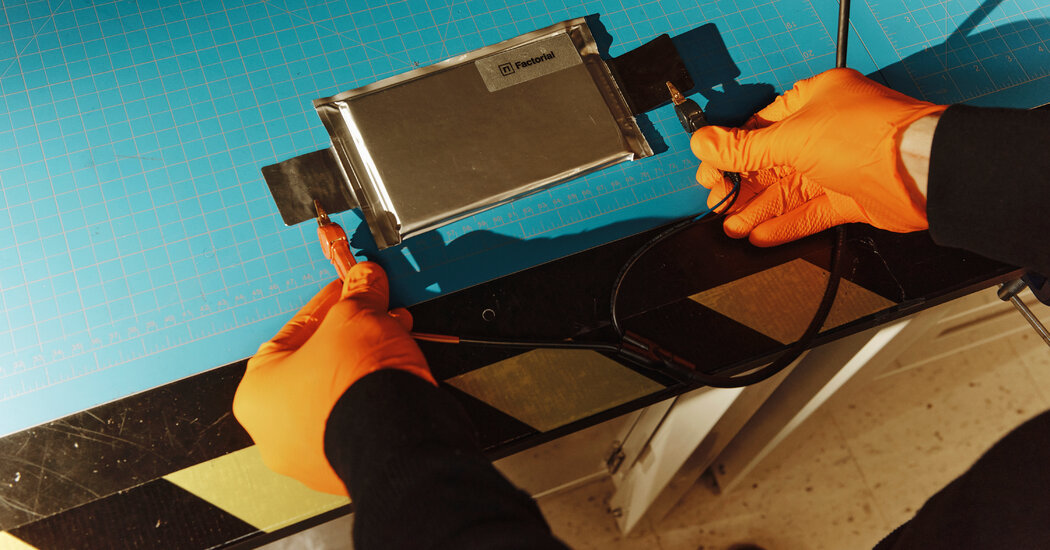
WOBURN, Mass. — Already far behind Asian manufacturers in building electric car batteries, U.S. automakers and their suppliers are racing to develop a new generation of batteries that are cheaper, can pack in more energy and charge faster.
It is a global contest with huge economic consequences for automakers, small battery start-ups and car buyers, who in a few years will choose from a dizzying array of electric cars that use different kinds of batteries as the combustion engine era recedes.
The chemical makeup of batteries — a technical subject that was the province of engineers — has become one of the hottest topics of discussion in the corporate boardrooms of General Motors, Toyota, Ford Motor and Volkswagen, as well as in the White House.
With financial and technological support from the government, these giant companies are embracing start-ups working to remake the battery so they are not left behind by the industrial revolution unleashed by the electric car.
Automakers’ ability to master battery technology could help determine which companies thrive and which are overtaken by Tesla and other electric car businesses.
Batteries will help determine the price of new cars and could become the defining feature of vehicles. Like the megapixels on cameras or the processing speeds of computer chips that consumers once obsessed over, the features of batteries will be the yardstick by which cars and trucks are judged and bought.
“This is going to be the new brand differentiation going forward — the battery in electric vehicles,” said Hau Thai-Tang, chief product platform and operations officer at Ford Motor. “So we’re making a huge effort.”
Batteries, of course, will also play a central role in the fight against climate change by helping to move cars, trucks and the power sector away from oil, coal and natural gas.
Automakers are taking a crash course in battery chemistry because demand for electric cars is taking off. Companies have to figure out how to make batteries cheaper and better. Today, batteries can make up a quarter to a third of the cost of electric cars. And most of those batteries are made by a few Asian companies.
Even Tesla, the dominant producer of electric cars, relies on Asian suppliers and is seeking to bring more manufacturing in house.
President Biden this month encouraged companies to move more of the battery supply chain to the United States. Russia’s invasion of Ukraine underlined the strategic importance of such efforts. Volkswagen was forced to temporarily shut down its main electric vehicle factory in Germany after the fighting disrupted the supply of parts made in western Ukraine.
A Critical Year for Electric Vehicles
The popularity of battery-powered cars is soaring worldwide, even as the overall auto market stagnates.
Auto giants like Stellantis, which owns Ram and Jeep, are lavishing cash on start-ups like Factorial Energy, which has fewer than 100 employees in an office park in Woburn, near Boston.
Factorial executives, who have stopped returning calls from automakers offering bags of money, are developing a battery that can charge faster, hold more energy and be less likely to overheat than current batteries.
“Money can come and go,” said Siyu Huang, a co-founder at Factorial, who began experimenting with battery technology as a graduate student at Cornell University. “We want to deliver the safest battery and change the way people are living.”
Top Biden administration officials have said they want to help, acknowledging that the United States has done a poor job capitalizing on battery technologies created domestically. Many of those inventions have given birth to a huge industry in China.
The Energy Department is considering financing companies that make batteries or supply the parts or critical minerals needed to build them. The agency already has at least 10 pending applications asking for a total of more than $15 million to support these battery-related projects, according to an agency tally.
The transportation secretary, Pete Buttigieg, said last month that a failure to innovate hurt his hometown, South Bend, Ind., once home to Studebaker, which went out of business in the 1960s.
“Innovation is central to the past, present and future for our auto industry, and we see that right now with the opportunity for America to lead the electric vehicle revolution,” he said.
Cheaper and More Durable Batteries
The most immediate change coming is in the building blocks of batteries.
Most lithium ion batteries used in electric vehicles rely on nickel, manganese and cobalt. But some automakers, including Tesla and Ford, are moving to use batteries in at least some vehicles that rely on lithium iron phosphate, which is popular in China.
These LFP batteries, as they are known, cannot store as much energy per pound, but they are much less expensive and last longer.
Tesla plans to offer LFP batteries in shorter-range, lower priced electric vehicles. Ford is planning to use them in some trucks sold under its Ion Boost Pro brand for fleet owners.
“It could be delivery, it could be plumbers, electricians, landscapers that work in a fixed geographic zone,” said Mr. Thai-Tang, the Ford executive.
Ford is teaming up with SK Innovation of Korea to make its batteries, but it hopes to bring much of that manufacturing to the United States, Mr. Thai-Tang said. “That will reduce some of the geopolitical as well as just logistics cost challenges.”
But the LFP battery is not a complete solution. Teslas using these batteries can drive only about 270 miles on a charge, compared with about 358 miles for similar models powered by nickel and cobalt batteries. Also, LFP batteries can lose some of their power when the temperature drops below freezing and take longer to charge.
New Designs and Ingredients
Ford’s new electric F-150 pickup truck, which has not gone on sale but already has 200,000 reservations, will rely on batteries with a higher percentage of energy-dense nickel, also made by SK Innovation.
Tesla in February said that it had already built one million cells for its next-generation “4680” battery that it has started to use in its Model Y crossovers. The automaker’s chief executive, Elon Musk, has said the battery will have 16 percent more range because of its distinctive honeycomb design. “It’s hard until it’s discovered, and then it’s simple,” he said in 2020.
G.M. claims that its Ultium battery cell needs 70 percent less cobalt than the cells used in the Chevrolet Bolt electric hatchback. The company has added aluminum to its battery. The GMC Hummer pickup, which G.M. recently started selling, is the first vehicle to have this battery.
G.M., in partnership with South Korea’s LG Chem, is building a $2.3 billion battery factory in Lordstown, Ohio. It is one of at least 13 large battery factories under construction in the United States.
Batteries are already becoming important to auto branding — G.M. is running ads for Ultium batteries. It adds to the imperative that they ensure these batteries are reliable and safe. G.M. has had to recall the Bolt to fix a battery defect that can lead to fires.
Many automakers are eager to reduce their reliance on cobalt in part because it mostly comes from the Democratic Republic of Congo, where it is mined by Chinese-financed companies or by freelancers who sometimes employ children.
“It’s the potential violation of human rights, the child labor or the artisan miners who are digging under very difficult circumstances — that’s the major concern that we have,” said Markus Schäfer, a senior Mercedes executive responsible for research and development.
The auto industry is also concerned about nickel, because Russia is an important supplier of the metal.
A team of about 25 government scientists at the Oak Ridge National Lab wants to push these innovations further still.
Conventional electric car batteries have been set up next to an experimental cobalt-free alternative. Scientists spend weeks charging and discharging them, measuring how they perform. Ilias Belharouak, who runs the Oak Ridge Battery Manufacturing Center, said the goal was to cut battery costs by as much as half, increase their range beyond 300 miles and get charge times down to 15 minutes or less. (Current batteries typically take 30 minutes to 12 hours to charge depending on the car and outlet.)
Some of this work will be funded by $200 million the Energy Department allocated late last year to seven national labs. The department next month will host a “virtual pitchfest” where battery designers present ideas to scientists, government officials and industry executives.
The Quest for Solid-State Batteries
Factorial Energy and other U.S. start-ups, such as Solid Power and QuantumScape, are aiming to revolutionize the way batteries are constructed, not just change their ingredients. Batteries today rely on a liquid solution for the electrolyte that allows the flow of electricity between different components.
Solid-state batteries don’t have a liquid electrolyte and, thus, will be lighter, store more energy and charge faster. They are also a lot less likely to ignite and, therefore, need less cooling equipment.
Most major carmakers have placed big bets on solid state technology.
Volkswagen has put its money on QuantumScape, based in San Jose, Calif. BMW and Ford are wagering on Solid Power, based in Louisville, Colo. G.M. has invested in SolidEnergy Systems, which emerged from the Massachusetts Institute of Technology and is based in Singapore.
But it’s not clear how soon solid-state batteries will arrive. Stellantis has said it hopes to introduce mass-market vehicles with those batteries by 2026, but executives at other companies say the technology might not be broadly available until about 2030.
Whichever carmaker offers solid state batteries first will have an enormous advantage.
Ms. Huang of Factorial said that it was not unusual for her and her business partner, Alex Yu, to work all night as they race to achieve technical benchmarks.
She is motivated, she said, by memories of the polluted air she breathed while growing up near Shanghai. “Our company’s founding mission is to strive toward a fossil free future,” Ms. Huang said. “That is what I strive for in my life.”
Eventually, Factorial, which Mercedes-Benz and Hyundai have also invested in, wants to build factories around the world — an ambitious goal considering the company just moved into a second floor.
In a series of laboratories, employees wearing white coats and intense expressions test prototype cells.
Despite this frenzied activity, the auto industry could struggle to fill demand for new batteries because the world cannot mine and process all the raw materials needed, particularly for lithium, said Andrew Miller, chief operating officer at Benchmark Minerals Intelligence, which tracks battery makers and supplies worldwide.
“All of the models that are being announced, everything those companies want to do over the next three years,” Mr. Miller said, “I don’t know where the raw materials are coming from.”




